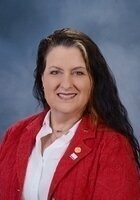All Common Core: High School - Algebra Resources
Example Questions
Example Question #21 : High School: Algebra
Use the GCF method to rewrite the following expression.
To use the GCF method to rewrite the expression, first recall what the GCF method means.
GCF stands for 'Greatest Common Factor' which means the largest factor or factors that belong to all terms in the expression.
In general terms,
Looking at the expression in question, break down each term into its factors.
The factors that belong to both terms are:
Factoring out the GCF leaves:
Rewriting the expression, results in the following equivalent expression.
Example Question #1 : Rewriting Expressions Using Its Structure: Ccss.Math.Content.Hsa Sse.A.2
Use the GCF method to rewrite the following expression.
To use the GCF method to rewrite the expression, first recall what the GCF method means.
GCF stands for 'Greatest Common Factor' which means the largest factor or factors that belong to all terms in the expression.
In general terms,
Looking at the expression in question, break down each term into its factors.
The factors that belong to both terms are:
Factoring out the GCF leaves:
Rewriting the expression, results in the following equivalent expression.
Example Question #22 : High School: Algebra
Use the GCF method to rewrite the following expression.
To use the GCF method to rewrite the expression, first recall what the GCF method means.
GCF stands for 'Greatest Common Factor' which means the largest factor or factors that belong to all terms in the expression.
In general terms,
Looking at the expression in question, break down each term into its factors.
The factors that belong to both terms are:
Factoring out the GCF leaves:
Rewriting the expression, results in the following equivalent expression.
Example Question #23 : High School: Algebra
Use the GCF method to rewrite the following expression.
To use the GCF method to rewrite the expression, first recall what the GCF method means.
GCF stands for 'Greatest Common Factor' which means the largest factor or factors that belong to all terms in the expression.
In general terms,
Looking at the expression in question, break down each term into its factors.
The factors that belong to both terms are:
Factoring out the GCF leaves:
Rewriting the expression, results in the following equivalent expression.
Example Question #2 : Rewriting Expressions Using Its Structure: Ccss.Math.Content.Hsa Sse.A.2
Use the GCF method to rewrite the following expression.
To use the GCF method to rewrite the expression, first recall what the GCF method means.
GCF stands for 'Greatest Common Factor' which means the largest factor or factors that belong to all terms in the expression.
In general terms,
Looking at the expression in question, break down each term into its factors.
The factors that belong to both terms are:
Factoring out the GCF leaves:
Rewriting the expression, results in the following equivalent expression.
Example Question #24 : High School: Algebra
Use the GCF method to rewrite the following expression.
To use the GCF method to rewrite the expression, first recall what the GCF method means.
GCF stands for 'Greatest Common Factor' which means the largest factor or factors that belong to all terms in the expression.
In general terms,
Looking at the expression in question, break down each term into its factors.
The factors that belong to both terms are:
Factoring out the GCF leaves:
Rewriting the expression, results in the following equivalent expression.
Example Question #3 : Rewriting Expressions Using Its Structure: Ccss.Math.Content.Hsa Sse.A.2
Factor the quadratic expression.
To factor the quadratic expression
set up the expression in factored form, leaving blanks for the numbers that are not yet known.
At this point, you need to find two numbers - one for each blank. By looking at the original expression, a few clues can be gathered that will help find the two numbers. The product of these two numbers will be equal to the last term of the original expression (10, or c in the standard quadratic formula), and their sum will be equal to the coefficient of the second term of the original expression (7, or b in the standard quadratic formula). Because their product is positive (10), that must mean that they have the same signs.
Now, at this point, test a few different possibilities using the clues gathered from the original expression. In the end, it's found that the only numbers that work are 2 and 5, as the product of 2 and 5 is 10, and sum of 2 and 5 is 7. So, this results in the expression's factored form looking like...
Example Question #4 : Rewriting Expressions Using Its Structure: Ccss.Math.Content.Hsa Sse.A.2
Factor the quadratic expression.
To factor the quadratic expression
set up the expression in factored form, leaving blanks for the numbers that are not yet known.
At this point, you need to find two numbers - one for each blank. By looking at the original expression, a few clues can be gathered that will help find the two numbers. The product of these two numbers will be equal to the last term of the original expression (-4, or c in the standard quadratic formula), and their sum will be equal to the coefficient of the second term of the original expression (-3, or b in the standard quadratic formula). Because their product is negative (-4), that must mean that they have different signs.
Now, at this point, test a few different possibilities using the clues gathered from the original expression. In the end, it's found that the only numbers that work are -4 and 1, as the product of -4 and 1 is -4, and sum of -4 and 1 is -3. So, this results in the expression's factored form looking like...
Example Question #33 : High School: Algebra
Factor the quadratic expression.
To factor the quadratic expression
set up the expression in factored form, leaving blanks for the numbers that are not yet known.
At this point, you need to find two numbers - one for each blank. By looking at the original expression, a few clues can be gathered that will help find the two numbers. The product of these two numbers will be equal to the last term of the original expression (4, or c in the standard quadratic formula), and their sum will be equal to the coefficient of the second term of the original expression (-4, or b in the standard quadratic formula). Because their product is positive (4) and the sum is negative, that must mean that they both have negative signs.
Now, at this point, test a few different possibilities using the clues gathered from the original expression. In the end, it's found that the only numbers that work are -2 and -2, as the product of -2 and -2 is 4, and sum of -2 and -2 is -4. So, this results in the expression's factored form looking like...
Example Question #34 : High School: Algebra
Factor the quadratic expression.
To factor the quadratic expression
set up the expression in factored form, leaving blanks for the numbers that are not yet known.
At this point, you need to find two numbers - one for each blank. By looking at the original expression, a few clues can be gathered that will help find the two numbers. The product of these two numbers will be equal to the last term of the original expression (-4, or c in the standard quadratic formula), and their sum will be equal to the coefficient of the second term of the original expression (0, or b in the standard quadratic formula). Because their product is negative (-4) and the sum is zero, that must mean that they have different signs but the same absolute value.
Now, at this point, test a few different possibilities using the clues gathered from the original expression. In the end, it's found that the only numbers that work are 2 and -2, as the product of 2 and -2 is -4, and sum of 2 and -2 is 0. So, this results in the expression's factored form looking like...
This is known as a difference of squares.
All Common Core: High School - Algebra Resources







































































































